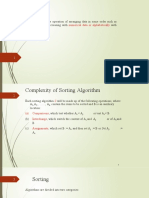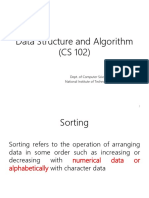0% found this document useful (0 votes)
8 views18 pagesSorting
The document discusses sorting algorithms, which are essential for organizing records in databases, with examples like telephone directories and dictionaries. It details three types of sorting algorithms: Bubble Sort, Selection Sort, and Insertion Sort, providing explanations and code examples for each. The worst-case complexity for both Bubble Sort and Insertion Sort is O(n^2).
Uploaded by
reachmihirjhaCopyright
© © All Rights Reserved
We take content rights seriously. If you suspect this is your content, claim it here.
Available Formats
Download as PDF, TXT or read online on Scribd
0% found this document useful (0 votes)
8 views18 pagesSorting
The document discusses sorting algorithms, which are essential for organizing records in databases, with examples like telephone directories and dictionaries. It details three types of sorting algorithms: Bubble Sort, Selection Sort, and Insertion Sort, providing explanations and code examples for each. The worst-case complexity for both Bubble Sort and Insertion Sort is O(n^2).
Uploaded by
reachmihirjhaCopyright
© © All Rights Reserved
We take content rights seriously. If you suspect this is your content, claim it here.
Available Formats
Download as PDF, TXT or read online on Scribd
/ 18
























































































